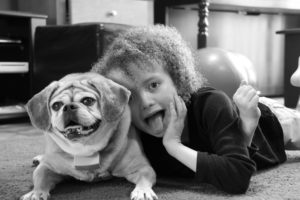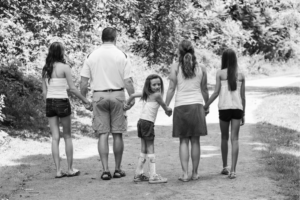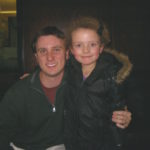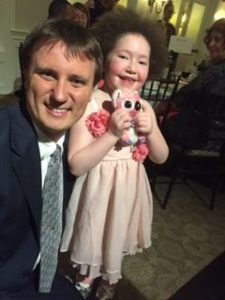After Gene Therapy: Hannah’s Journey Continues
Thirteen-year-old Hannah Sames looked beautiful two weeks ago at the annual Hannah’s Hope Fund gala near her hometown and mine. She’d put on 15 pounds since her gene therapy for giant axonal neuropathy (GAN) 9 months ago. Hannah wheeled around the teen-packed ballroom, a few kinky tendrils of her curls escaping an elegant upsweep and draping her smile, chatting with guests.
I looked at her in wonder. Were the extra pounds a response to gene therapy, or just a normal adolescent growth spurt? Were her new abilities to pull herself up from a sitting position and to pick up a crouton with her fingers a consequence of subconsciously trying harder? Or were they, too, due to the trillions of gene-bearing viruses sent into her spinal cord fluid? Had the genes reached her motor neurons?
It’s too soon to tell.

But if Hannah’s gene therapy had been delivered, why the gala, with silent and live auctions, to raise thousands of dollars more? When the bidding to see Pitbull in Vegas opened at $2200, I sat right back down and then watched a case of wine go for nearly twice that, my brain trying to translate the dollars into number of viral vectors needed to treat more than the 9 kids who’ve already received the gene therapy since the trial began at the NIH Clinical Center nearly two years ago.
Wasn’t gene therapy supposed to be a “forever fix”?
Didn’t someone – me – write a book about gene therapy with that title? It was Hannah’s mom Lori who uttered it while we were at an event years ago.
A FIRST STEP, OR A FOREVER FIX?
For some diseases, like GAN, gene therapy may be a first step, to halt progression, so that other treatments, perhaps even another gene therapy, can then step in. If the initial gene therapy prolongs survival, it might reveal aspects of a disease unknown because young children would die before they’d develop other symptoms, while kids with milder or “atypical presentations” of the disease might never have been accurately diagnosed. After all, only 73 people in the world are known to have GAN. It causes an ALS-like disease that typically ends in the third decade of life.
Pompe disease provides a precedent for a treatment revealing unsuspected symptoms. When enzyme replacement therapy extended survival beyond a few months by a year or more, children who had been improving again required mechanical ventilation. Why? As their very enlarged hearts had shrunk thanks to the enzyme replacement, burden fell onto the phrenic nerves to the diaphragm, impairing lung function. Research focus shifted to the neuromuscular junctions, a target overlooked at first.
 And so gene therapy, at least for some diseases, may turn out to be more than a one-time infusion of gene-bearing viruses. Questions abound.
And so gene therapy, at least for some diseases, may turn out to be more than a one-time infusion of gene-bearing viruses. Questions abound.
- Where do the viruses actually go? Do they venture beyond the “tropisms” engineered onto their exteriors?
- How many viruses enter the targeted cells types?
- Once inside cells, do the needed genes function?
- Have anti-rejection protocols worked?
- What is the most informative way to monitor or measure effects, and when?
- Are biomarkers ever enough, or should a child demonstrate a skill?
- What can we learn from treated kids, about dosage and timing and after-care, to improve the experiences of future trial participants?
These factors are why Hannah’s Hope and other organizations that have funded gene therapy trials already off the ground, like the Cure Sanfilippo Foundation (see Eliza Gets Her Gene Therapy), are still fundraising, and perhaps always will be.
As Hannah’s parents and the gene therapy team await and analyze her progress, they’re looking for what the delivered genes didn’t reach. “GAN gets every nerve cell in the body, but the first injection didn’t hit the optic nerves sufficiently. So in 6 years Hannah may need a subsequent injection,” explains Lori, or else Hannah’s vision may fade.

“We all recognized that the existing treatment was aimed at the most critical aspects of GAN, but that it wasn’t a completely comprehensive treatment, a cure. That’s why the work needs to keep going,” Steve Gray, from the Gene Therapy Center University of North Carolina at Chapel Hill and who designed the GAN vector, told me.
Ongoing work in knockout mice who, like Hannah, have deleted gigaxonin genes, reveals that the disease also affects the digestive tract, and perhaps other outposts of the peripheral nervous system. Animal studies are not just the preclinical boost to jumpstart a clinical trial – they must continue, especially as time passes after gene delivery, to guide investigators.
Meanwhile, the post-gene-therapy world is taxing for the patient. “Rehabilitation is critical! Hannah won’t just get up and start walking. It will take hard work and determination to get muscles strong enough to support ambulation. Thankfully, Hannah is inspired to work hard!” Lori says.
REACHING TARGET CELLS
It’s difficult to know at the start of planning a gene therapy clinical trial how many cells will have to be reached and respond to make a difference, to exert a measurable effect. Designing the treatment depends on the anatomical and physiological details of a single-gene disease, as well as the “natural history,” the time trajectory of signs and symptoms.

Like GAN, experimental gene therapy that has enabled more than 200 people with RPE65-mediated inherited retinal disease to see targeted one body part – the thin layer of retinal pigment epithelium that hugs the photoreceptors (rods and cones). Will the rapid and dramatic improvement persist? Or will photoreceptors outside the injection site continue to degenerate? And if they do, will it matter? That’s why the blindness trial that is at the heart of my book is following patients for 15 years, and why the GAN trial wraps up in 2030: a booster may become necessary. Over time though, even a gene therapy requiring boosters may be significantly cheaper than enzyme replacement therapies that require bimonthly infusions over a lifetime.
The gene therapies for GAN and RPE65 blindness have limited targets — the spinal cord and eye, respectively. Dr. Gray describes the engineered adeno-associated viruses that go into GAN patients. “It is like we put it in a river and let it flow to where it needs to go – the brain, spinal cord, a little to the outside.”
The first gene therapy trials, in the early 1990s, had more pervasive targets, inserting engineered viruses into patients’ cells outside the body, or “ex vivo,” and then infusing the cells. When those cells are stem cells, with their defining characteristic of self-renewal, a lifelong effect may indeed be possible. That’s the case for a growing list of blood stem cell borne gene therapies: two types of severe combined immune deficiency (SCID-ADA deficiency and SCID-X1), sickle cell disease, metachromatic leukodystrophy, and adrenoleukodystrophy. (All of these add genes – they don’t replace them, as gene editing can do.)

NOT A CURE
I’ve attended meetings where the companies developing and commercializing gene therapy describe a cassette-like system in which the genes behind selected diseases are slotted into validated viral delivery systems, one at a time. That vision is why Dr. Gray is now developing mouse models and/or designing vectors for 20 conditions. Each success boosts another. “If we can deliver the GAN gene, we can deliver genes in more difficult diseases — Batten, Krabbe, and others even more brutal than GAN because they are fatal before age 6,” he said at the gala.
But Dr. Gray was careful to temper expectations of Hannah’s gene therapy. “As much as I want this to be a cure, it is not. It is the best we can do today. But it’s a treatment. We’re still working on a cure. We need to target more critical aspects that we learned about from studying this disease. The gene therapy is buying the kids time to work towards a cure. We may want to stop and celebrate, but we have to keep working. The fight’s not over.”
I’ve called Steve Gray Hannah’s Hero. He shares that honor with the other heroines and heroes — the young participants in the first gene therapy trials for their diseases, and their brave families.

[…] Source: After Gene Therapy: Hannah’s Journey Continues […]
[…] sick to meaningfully respond and yield useful information. Hannah Sames, whom I’ve written about many times, was just weeks from being too sick to have her gene therapy for giant axonal neuropathy last […]